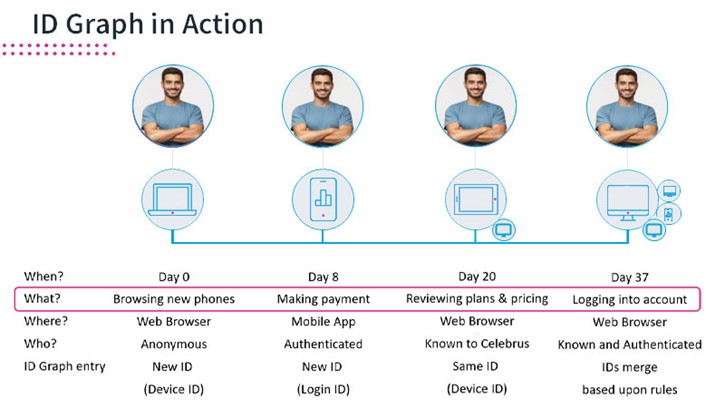Data plays an integral role in the success of a marketing campaign. Without data, it's impossible to understand what your customers want or how they interact with your brand online.
Modern businesses collect a ton of data to gain insight into behavior and preferences. Often, however, that data is imperfect and scattered.
When data is scattered across multiple systems, identity gaps are created.
Identity is the key ingredient that powers business growth, and identity gaps can become a barrier because they limit marketers' ability to create a unified view of a customer.
As a marketer, your goal is to deliver real-time, relevant, and engaging experiences to propel your brand forward, so it's imperative that you work to close customer identity gaps.
How Do Identity Gaps Occur?
When organizations cannot connect the dots of a single customer's activity across multiple interactions with their brand (or brands), that's an identity gap.
Identity gaps occur when businesses lack a complete understanding of their visitors' identities and behaviors. Without a complete understanding of the customer, businesses cannot provide personalized experiences that meet individual needs and preferences.
The result is simply a missed opportunity. Brands can't tailor marketing efforts and brand interactions to customers, inadvertently delivering poor customer experiences, promoting a decrease in customer loyalty, and ultimately causing revenue loss and decreased business growth.
Third-party data capture always creates identity gaps, either because the data wasn't captured at all, it expired, or the data wasn't shared back to the organization. The most common identity gaps today are those related to anonymous visitors, cross-domain roadblocks, data timeout, and missing data.
1. Anonymous Visitors
Traditional customer data platforms (CDPs) and identity resolution solutions can't identify anonymous visitors. To build a comprehensive identity graph, you must capture data from the moment a visitor lands on your site, regardless of authentication, then retain and catalog that information to connect it back to known users when they do authenticate.
2. Cross-Domain Roadblocks
Most identity resolution solutions can't persist across corporate-owned domains. That means that for multibrand properties, valuable data is lost. Even subdomains create separate profiles for the same user, resulting in massive identity gaps.
3. Data Timeout
Because most data solutions use third-party cookies, the data expires after 7-14 days. Expiration of device and third-party IDs makes it impossible to maintain an accurate identity over time by continually evolving the ID, creating multiple, disjointed profiles that can't be resolved in real-time.
4. Missing Data
Legacy CDPs rely on tagging to capture data, which means if you don't tag for it, you don't have it. Third-party cookies are often blocked entirely. That creates identity gaps relating to behaviors and interests that could have informed much more relevant experiences for your customers.
The Power of Customer Identity to Drive Growth
To close identity gaps and unlock growth, marketers should first focus on capturing a comprehensive data set that spans multiple touchpoints, allowing for detailed customer insight.
Once you have detailed insight on a customer, you can compile it into a single identity graph in real-time.
A first-party identity graph creates a unified and holistic view of individual customers or users by connecting various data points associated with them. Those data points may include demographic information, browsing behavior, purchase history, preferences, engagement metrics, and other relevant data.
The graph helps in identifying and understanding individual customers across multiple devices and touchpoints. By mapping and linking those data points, marketers can gain insight into customer behavior, personalize marketing campaigns, improve customer experiences, and make data-driven business decisions.
You can build an impressive 360-degree view of the customer, beginning with the first time a customer visits one of your digital properties and continuing over potentially years of interactions.

What About Compliance and Privacy Regulations?
A first-party identity graph unlocks more customer understanding than a basic third-party customer profile by casting a wider net to identify someone in a compliant manner as quickly as possible.
First-party data is obtained (and retained) by the organization the customer is interacting with, and its use is governed by privacy regulations and policies. Companies must ensure they handle and protect that data responsibly and in compliance with data protection laws.
Compliance requires organizations to collect and process only the necessary data for specific purposes, obtaining and managing customer consent. When building an identity graph, it's important to ensure that data collection and integration adhere to the principle of data minimization.
Also, the use of the identity graph should be limited to its intended purposes and not extend beyond what has been communicated to the customers.
* * *
By capturing granular data across channels and devices and connecting it to a centralized system with a unified identity graph, marketers can analyze valuable consumer data in real-time to inform personalized marketing campaigns and optimize the customer experience.
Marketers can bridge customer context to develop a deeper understanding of their customers.
Closing identity gaps allows for more effective targeting and segmentation, messaging, and brand-building, ultimately leading to better identity-based engagement and business success.
More Resources on Customer Identity
Third-Party Cookie and Data Deprecation: What's a Marketer to Do?
The Fight Against Bot Traffic: Three Ways Marketing and Security Can Partner
Great CX Calls for New Strategies and Stronger Collaboration




